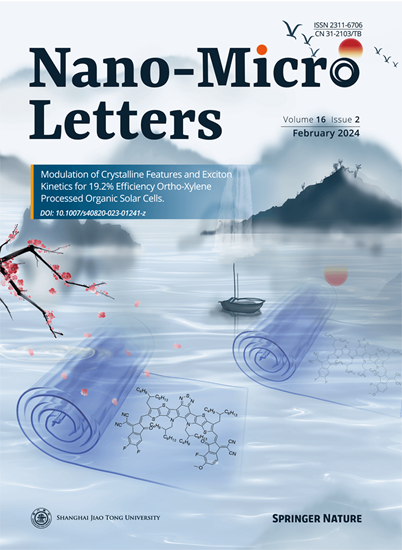通过电气化界面优化和协同转换设计稳定锂金属电池的金属磷化物固液界面。
IF 36.3
1区 材料科学
Q1 Engineering
引用次数: 0
摘要
调节锂金属的成核和生长对于实现稳定的高能量密度锂金属电池(lmb)至关重要,因为它没有枝晶锂生长、严重的体积膨胀和“死锂”积累。在此,我们提出了一个由多孔SnP0.94/CoP p-n异质结粒子(SCP)组成的调制层,利用Kirkendall效应合成。SCP中独特的异质界面诱导了一个完全电离的耗尽区和内置电场。这提供了强的锂亲和力,额外的吸附位点,并促进了电子转移,从而指导无枝晶的锂成核/生长,具有低的锂沉积过电位。此外,考虑到SCP与Li的反应,SCP的战略设计在渐进循环中产生了导电的Co,亲锂的Li- sn合金和离子导电的Li3P。电子离子混合导体(MEIC)保证了SCP调制层的长期稳定性。有了这一层,SCP@Li对称电池即使在5ma cm-2的高电流密度下也能保持750次低过电位。此外,LiFePO4//SCP@Li全电池在0.5 c下循环800次,每循环可实现0.03%的难以察觉的容量衰减。本文章由计算机程序翻译,如有差异,请以英文原文为准。
Designing Metal Phosphide Solid-Electrolyte Interphase for Stable Lithium Metal Batteries Through Electrified Interface Optimization and Synergistic Conversion.
Regulating the nucleation and growth of Li metal is crucial for achieving stable high-energy-density Li metal batteries (LMBs) without dendritic Li growth, severe volume expansion, and "dead Li" accumulation. Herein, we present a modulation layer composed of porous SnP0.94/CoP p-n heterojunction particles (SCP), synthesized applying the Kirkendall effect. The unique heterointerfaces in the SCP induce a fully ionized depletion region and built-in electric field. This provides strong Li affinity, additional adsorption sites, and facilitated electron transfer, thereby guiding dendrite-free Li nucleation/growth with a low Li deposition overpotential. Moreover, the strategic design of the SCP, accounting for its reaction with Li, yields electronically conductive Co, lithiophilic Li-Sn alloy, and ionic conductive Li3P during progressive cycles. The mixed electronic and ionic conductor (MEIC) ensure the long-term stability of the SCP modulation layer. With this layer, the SCP@Li symmetric cell maintains a low overpotential for 750 cycles even at a high current density of 5 mA cm-2. Additionally, the LiFePO4//SCP@Li full cell achieves an imperceptible capacity decay of 0.03% per cycle for 800 cycles at 0.5 C. This study provides insight into MEIC heterostructures for high-performance LMBs.
求助全文
通过发布文献求助,成功后即可免费获取论文全文。
去求助
来源期刊

Nano-Micro Letters
NANOSCIENCE & NANOTECHNOLOGY-MATERIALS SCIENCE, MULTIDISCIPLINARY
CiteScore
32.60
自引率
4.90%
发文量
981
审稿时长
1.1 months
期刊介绍:
Nano-Micro Letters is a peer-reviewed, international, interdisciplinary, and open-access journal published under the SpringerOpen brand.
Nano-Micro Letters focuses on the science, experiments, engineering, technologies, and applications of nano- or microscale structures and systems in various fields such as physics, chemistry, biology, material science, and pharmacy.It also explores the expanding interfaces between these fields.
Nano-Micro Letters particularly emphasizes the bottom-up approach in the length scale from nano to micro. This approach is crucial for achieving industrial applications in nanotechnology, as it involves the assembly, modification, and control of nanostructures on a microscale.
 求助内容:
求助内容: 应助结果提醒方式:
应助结果提醒方式:


